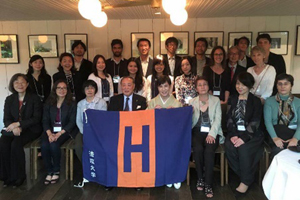Friday, October 28
In the evening, I had the opportunity to talk with a group of faculty members interested in the issues facing the university. The usual question is how to balance a system of thorough savings aimed at accumulating finances for teaching and learning reforms with investment in solutions to the challenges at hand. There are many immediate issues, such as how to deal with the increase in the number of international students and how to tackle the challenges of the Tama campus in the short and long term. But the first thing I have learned from you is that further dialogue is needed to realize the long-term vision we have formulated. I have long refrained from taking the President appearance because I was told, "This is the last time he will make an appearance." The Trustee and Vice President who are sincerely taking charge are very busy, the chairpersons are very active in the formulation of the vision, and the President office is very active in many areas, but I continue to think that dialogue by myself is not enough.
Wednesday, October 26
The forum for "extremely radical discussions" set up by the Ministry of Economy, Trade and Industry and the Editorial Engineering Research Institute is called the "Rethinking Japan Study Group. Tonight was another night of that discussion. The words dancing on the resumes are not bureaucratic. They include "Japan is stunned...Japan stands still," "Everything starts with facing reality," and so on. The policy being pressed for, though extensively discussed, is "how to shift fiscal spending, which is grossly skewed toward the elderly, to investment in education for the younger generation. Beyond that, as "Japan, a country with advanced problem-solving capabilities," there are a variety of solutions that can be devised, but in any case, there must be young people with higher education to make these solutions a reality. And there is a barrier to the transfer of public spending: the image of life created by Japan's postwar system of universal pensions, universal health care, and mandatory retirement age. No, it is not a barrier if the calculations are correct, but it is becoming one. I keep thinking about this as I will be a senior citizen in three months.
October 22 (Saturday)
I listened to six sets of presentations by career center staff about the work they have done and the challenges they are about to take on. One of them was an attempt to increase the number of participants by using postcards to notify students of job-hunting events. Another was a proposal to introduce a work-type program in addition to lectures and individual counseling, and another was a secret plan to increase the number of U-turn job seekers. It was really interesting and entertaining. It was really interesting and entertaining. I came up with many new ideas, such as linking with regular classes. I look forward to hearing about the various practices and ideas from the staff of other departments.
October 21 (Fri.)
Ms. Miyoko Watanabe, Director of the Diversity Promotion Office of the National Institute of Science Faculty of Science and Engineering Technology Agency, visited us through the introduction of Professor Yukari Matsuo, a physicist in Faculty of Science and Engineering University, seeking our support and cooperation for the Gender Summit 10, which will be held in May 2017. The Gender Summit is an international conference that aims to improve the quality of research and innovation by regarding gender differences as an important factor in science. The theme of the conference is "Enhancing Science and Innovation through Gender and Diversity Promotion. Of course, we would like to co-sponsor the event.
Ms. Watanabe's talk was interesting. In animal experiments on drugs, males are used. This is because females do not produce stable results due to hormonal changes. However, he said that some drugs made in this way do not work on women. Also, car seat belts are based on the physique of an adult male. As a result, they say, they have led to the deaths of pregnant women. In fact, I suffer because the seatbelt rests on my neck, and I always put a handkerchief between them. I thought it was because of my short stature, but I was wrong.
I was shocked to learn that the trend of women who are interested in science in junior high school and high school not choosing science when they go on to college has not changed. What was more shocking was that the mental weakness of young men has become so pronounced that it has become a source of anxiety for the future of society. The time has finally come when the question of how to help men becomes a gender issue.
October 20 (Thursday)
This was the second roundtable discussion between the Ministry of Economy, Trade and Industry (METI) and the Editorial Engineering Institute. Many ideas on how to overcome the crisis were discussed, but I am not ready to report on them yet. It was certainly a stimulating and interesting discussion.
October 17 (Monday)
I received a notice from the wife of the late Professor Emeritus Masatoshi Sagara, a Faculty of Social Sciences professor and an expert in French history, that the Tokyo College of Music Library had begun to exhibit materials related to Masatoshi Sagara and his chansons. Flyers and pamphlets were also prepared.
I took over from Professor Sagara as chairman of the steering committee of the Institute of International Japanese Studies, and we worked hard together to stabilize the Institute of International Japanese StudiesGraduate School of Humanities, and to provide guidance for international students in their thesis work. After his death, a vast amount of chanson materials were found. 289 scores, 51 Japanese books, 975 Western books, and 116 recorded materials, totaling 1,431 items. Unfortunately, it was not the students and faculty of the University who would make use of these, I thought. Thanks to the efforts of Professor Emeritus Tate Ijuin of Faculty of Social Sciences and Professor Fumiko Kobayashi of the Faculty of Letters, they were housed at the Tokyo College of Music. Chansons are not only songs but also literature. I hope those who are interested in chanson will make use of it.
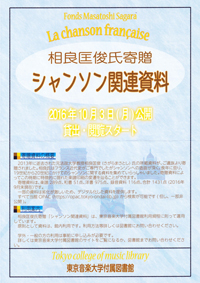
October 16 (Sun)
It has been a long time since I appeared on Sunday Morning. Of course, Bob Dylan will be discussed. Another topic of note is the major power outage that occurred in the city center on January 12. What should we do about our over-reliance on electricity? Instead of continuing to supply electricity as demanded, we should set the amount to be supplied, think through and devise ways within that range, and develop products accordingly. This is not to say that nothing could be done at night in the Edo period because there were only paper lanterns. Japanese culture was perfected through the publication of books and ukiyoe prints that could be read even with paper lanterns, and through the effective use of theaters without electricity. New possibilities emerge when one creates a life within limitations and adapts it accordingly.
In the afternoon, I gave a talk titled "People Coexisting with Natural Disasters" at a comparative literature meeting held at Hosei University's Gaihori Campus. This is also the same as how to live without electricity. People in the Edo period, who could not rely on the government, built temporary housing with shutters, fusuma (sliding doors), shoji screens, and tatami mats from collapsed houses, and brought things to each other to get by. The challenge, after all, is how to be a community in daily life.
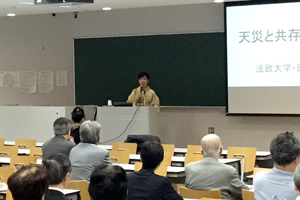
October 15 (Saturday)
The annual Tokyo Metropolitan Parents' Conference is held on three campuses, and I am supposed to visit each one in turn. This year, the meeting at the Tama campus was held on the day of the Tama Festival. The campus was very lively with clear skies and a refreshing autumn breeze. Parents enjoyed the spaciousness of the Tama Campus.
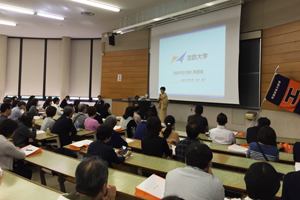
October 14 (Friday)
The general meeting of the University Standard Association, an organization of volunteer universities, was held. The Association is an organization for national, public, and private universities to set their own goals based on their own uniqueness before being regulated by the national government, and to carry out continuous reforms while self-evaluating themselves to achieve those goals. Every year, there is much to learn at the general meeting. This year, especially on the day when the details of the third phase of accreditation evaluation are announced, I feel that university reform must now more than ever clarify its goals, procedures, and results.
October 13 (Thursday)
This week I also returned to the Executive Trustee and the Trustee. The discomfort caused by the time difference has not yet been fixed, but I await a gradual recovery. Today is the day of the annual deans' meeting at the Tama Campus. After the meeting, a reception was held, and as many as three deans were women. The President office, the dean's office, and the staff members gathered in one corner for a lively conversation. During the conversation, the news came in that Bob Dylan had won the Nobel Prize in Literature. I was so happy that I got up and delivered the news to the deans, all of whom were considerably younger than me. Some of them did not seem to be aware of it.
Bob Dylan had a special place in the hearts of my generation and the baby boomers who came after us, as I picked up my guitar and sang "Blowin' in the Wind" during the folk boom of the late 1960s, which began a little later than in the United States. Social movements and singing were one and the same. Folk music brought about an era in which everyone sang their own songs, rather than entrusting them to professional singers. As the "folk guerrillas" described it, people sang anywhere, in Shinjuku West Exit Plaza, on the streets, and in schools. Bob Dylan was the starting point and symbol of this movement.
There is another meaning to this award. It is the return of song to the world of literature. Japanese literature is based on poetry. The Kikki poetry, Manyoshu, and Kokin Wakashu are all based on poetry. The foundation of Japanese literature has always been poetry, including the Kiki Uta Shu, Manyoshu, and Kokin Waka Shu, as well as the Ryohin Hisho and Noh noh chants. Stories were also born from songs. Songs had intonation and rhythm, and some literature, such as the Tale of the Heike, was accompanied by biwa accompaniment, while others, such as joruri, were accompanied by shamisen accompaniment. With the beginning of modern literature, the novel was placed at the center of literature, and songs and narratives were relegated to the background. The selection of the Nobel Academy has once again broadened the concept of literature to its original state.
October 6 (Thursday)
A few days in London, I jogged along the Thames River from my hotel in STRAND to Big Ben. And on the last day of my business trip to Europe, I took a boat ride on the Thames. In the Edo period (1603-1867), people used the river as a means of transportation on a daily basis, especially the Sumida River. Paris, London, and Edo all developed on rivers and canals, and in order to experience a bit of 18th century mobility, I have taken boats whenever I had the chance, in China, Vienna, and various other places. Born and raised in Yokohama, the sea and its harbors are also the starting point of my experience. The waterside is where the world expands. I will fold up what has expanded and return home.
October 5 (Wed)
I spoke at the Jiji Press London Top Seminar. The Lansdowne Club, the venue of the seminar, was one of the first of the many gentlemen's clubs in London to open its doors to women. It was also the venue for the signing ceremony of the Anglo-Japanese Alliance in 1902. The lecture was attended by about 100 people, mostly from the embassy, various international organizations, and top executives of Japanese companies operating in the UK. The Minister and Consul General in the U.K. and the Minister of State for Foreign Affairs also attended, and we met a wide variety of business people from trading companies, banks, securities firms, airlines, travel agencies, real estate companies, staffing agencies, media, and others.
London was abuzz with activity in the days following the pound's plunge. The city was full of buses, cars, and people, and I wondered if this was a remote cause of the possible exit from the EU. On the other hand, I learned from Mr. Hiratsuka, President accompanied me and is a professor of Faculty of Social Sciences specializing in education, that poverty is spreading even further among people in areas we do not enter, and which we do not see. Many university faculty and staff are blind to the poverty of young people and children who cannot even come to the university. But what is education without knowing that?
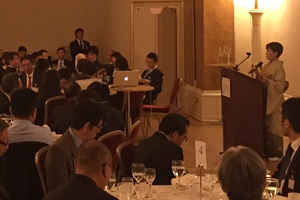
October 4 (Tuesday)
Last year, during a business trip to Europe by the European Alumni Association, I visited Roskilde University in Denmark, where I made an observation tour and concluded an inter-university agreement at the same time. I learned a great deal there. I felt as if I had been freed from the typical Japanese university. This year, I visited Birkbeck University, part of the University of London. If Oxford University is a collection of colleges, University of London is a federation of universities, and Birkbeck University will soon celebrate its 200th anniversary! The origin of Birkbeck University dates back to 1823, when 2,000 workers gathered in a pub in the Strand area of London and called for higher education opportunities for engineers. Since then, it has developed as an evening college for working adults. The university has five departments: natural sciences, law, humanities, business administration, and arts, with 8,000 undergraduate students and 900 graduate students. It offers courses from 6:00 to 9:00 p.m., four days a week. How can working people continue to study while they work? This is an issue for the entire world. Georgetown University in the United States has a School of Continuing Education. This made me think about how we can make use of the history of our School of Correspondence Education.

Professor Julian Swann, Vice President Research, and the Dean of the Faculty of Law talked about the university, toured the school building, and had lunch at the British Museum restaurant. Professor Swann's specialty is Early Modern France and the French Revolution, which overlaps with my research on the Edo period.
After that, we visited the Museum of London. The theme of the museum was London itself, and I thought that its planning might have been modeled after the Edo-Tokyo Museum. It is an interesting museum that unintentionally makes me interested in the history and structure of London. The current exhibition is The Great Fire of London. They are even making tote bags and scarves on the theme of "fire" of fire. I guess they would be hated in Japan if they made museum goods on the theme of the Great Meireki Fire.
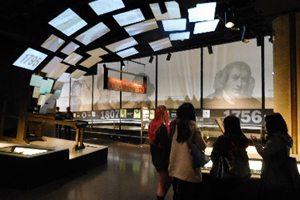
October 3 (Monday)
Hosei University is developing a new type of museum concept. In a nutshell, rather than a luxurious building, it is a museum that will showcase the university's accumulated research and educational achievements to the world, connecting the three university campuses and three affiliated schools. The people involved in the project have visited the museum in Japan. On this occasion, we took the opportunity to visit museums in Oxford and London. On this day, we visited the Pit Rivers Museum at the University of Oxford. It is an anthropological museum adjacent to the Natural Science Museum, and is filled with exhibits collected from all over the world, such as body ornaments, interior and exterior decorations, cloths, agricultural tools, fishing tools, swords, armor, and so on. It is the opposite of Hosei University's concept of an anthropology or ethnology museum, which is a thorough collection and thorough exhibition type. As a researcher, I found it very interesting, but Hosei University must go beyond this type of museum image.

I have been here several times. It was 1993, 23 years ago. I spent a year as a research fellow in an apartment on Water Eaton Road owned by an Oxford faculty member, visiting the Bodleian Library and Blackwell's Bookshop, and traveling to France, Holland, and Germany to write an English paper on the trading history of textiles. Water Eaton Road, with a view of a large meadow in the background, was where the cows were raised for Oxford University's food supply. I went for a short walk and was surprised to see how little the landscape had changed, including the apartment buildings. Considering that this is a 1000-year-old university and university town, Hosei University is still in its infancy.
Oxford University is made up of 39 colleges. I visited the Lamb and Flag pub, which is owned by one of the colleges. The pub uses all the proceeds from its sales to fund scholarships for students at the college. I would like to try this. Izakaya is, to begin with, a "place to gather" just like cafes in the UK and Japan. It is also a place for discussion. In some cases, they functioned as courts. When faculty members get together to eat and discuss, it becomes a scholarship. It is wonderful.
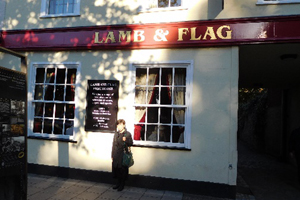
Sunday, October 2
After the Hosei meeting in Paris, I took the Eurostar to London. The UK Alumni Association General Meeting was held in London. This one has already established a formal Alumni Association. The UK Alumni Association was formed in 2012 when the 100-member European Hosei Meeting was held in London, and meets about twice a year. The group is made up of people from companies and Japanese organizations, a woman who has lived in the UK for 50 years and established a Japanese school in London, entrepreneurs, expatriate family members, etc. What I enjoyed about the UK Alumni Association was that several Hosei alumni were accompanied by their friends from other universities. The fun part of the UK Alumni Association was that several Hosei OGs were accompanied by their friends from other universities.
This time, too, I traveled to Europe with Mr. Kuwano, President of the Alumni Association, Mr. Hiratsuka, Director of the Office of the President Tohoku University, and a staff member of the Alumni Supporters' Association. Mr. Kuwano has served as vice president and then vice chairman of Akebono Brake, which operates in 13 countries around the world, and currently serves as an honorary advisor to the company. I was completely indebted to Ms. Mika Yamada, a local employee of Akebono Brake in France. Thanks to everyone in the Alumni Association, on and off campus, the Alumni Association has expanded once again. I am sincerely grateful to all of you.
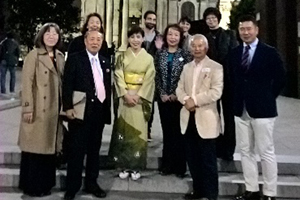
Saturday, October 1
Hosei Meeting in Paris was held at L'Alcazar in Paris. Nearly 30 people attended the meeting, including people who work for local companies, people in the cultural business field, Japanese language teachers, people who own companies in Paris, and current students studying abroad. Two women who left Japan and are now developing their careers in Paris were former students of Hosei Women's High School. Those who had lived in the area for decades and had never met Hosei alumni met on this occasion and made new connections. There was also the discovery of unexpected connections through mutual self-introductions. There will be more opportunities to help each other at work and in their personal lives. This is the reason why we are organizing overseas alumni associations.
As was the case at last year's gatherings in Belgium and Germany, there is a different atmosphere than at Alumni Associations in Japan. The reason for this is that families participate in these gatherings together. Not only their companions, but also their children. Some have been married to local people for a short time, others have been married for decades and have grown up with children, and so on. Some of them have been married for decades and their children have grown up. A French student who has returned to his home country also came. People who have thought and experienced various things at Hosei University, even if only for a time, and who have gone out into the world from there, notice the bulletin board in the newspaper and stop by. There, strangers of completely different generations meet each other anew. It may seem very strange, but this is what a university is, not only a place of learning, but also a "square of freedom. Universities have the function of creating connections in society once again, or even many times.
